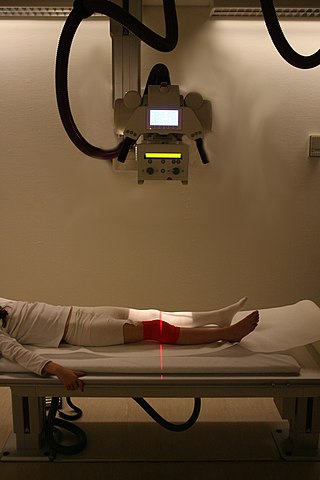
Radiography is an imaging technique using X-rays, gamma rays, or similar ionizing radiation and non-ionizing radiation to view the internal form of an object. Applications of radiography include medical and industrial radiography. Similar techniques are used in airport security,. To create an image in conventional radiography, a beam of X-rays is produced by an X-ray generator and it is projected towards the object. A certain amount of the X-rays or other radiation are absorbed by the object, dependent on the object's density and structural composition. The X-rays that pass through the object are captured behind the object by a detector. The generation of flat two-dimensional images by this technique is called projectional radiography. In computed tomography, an X-ray source and its associated detectors rotate around the subject, which itself moves through the conical X-ray beam produced. Any given point within the subject is crossed from many directions by many different beams at different times. Information regarding the attenuation of these beams is collated and subjected to computation to generate two-dimensional images on three planes which can be further processed to produce a three-dimensional image.

Radiology is the medical specialty that uses medical imaging to diagnose diseases and guide treatment within the bodies of humans and other animals. It began with radiography, but today it includes all imaging modalities. This includes technologies that use no ionizing electromagnetic radiation, such as ultrasonography and magnetic resonance imaging), as well as others that do use radiation, such as computed tomography (CT), fluoroscopy, and nuclear medicine including positron emission tomography (PET). Interventional radiology is the performance of usually minimally invasive medical procedures with the guidance of imaging technologies such as those mentioned above.
Medical physics deals with the application of the concepts and methods of physics to the prevention, diagnosis and treatment of human diseases with a specific goal of improving human health and well-being. Since 2008, medical physics has been included as a health profession according to International Standard Classification of Occupation of the International Labour Organization.
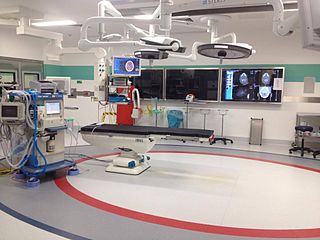
Interventional radiology (IR) is a medical specialty that performs various minimally-invasive procedures using medical imaging guidance, such as x-ray fluoroscopy, computed tomography, magnetic resonance imaging, or ultrasound. IR performs both diagnostic and therapeutic procedures through very small incisions or body orifices. Diagnostic IR procedures are those intended to help make a diagnosis or guide further medical treatment, and include image-guided biopsy of a tumor or injection of an imaging contrast agent into a hollow structure, such as a blood vessel or a duct. By contrast, therapeutic IR procedures provide direct treatment—they include catheter-based medicine delivery, medical device placement, and angioplasty of narrowed structures.

Minimally invasive procedures encompass surgical techniques that limit the size of incisions needed, thereby reducing wound healing time, associated pain, and risk of infection. Surgery by definition is invasive, and many operations requiring incisions of some size are referred to as open surgery. Incisions made during open surgery can sometimes leave large wounds that may be painful and take a long time to heal. Advancements in medical technologies have enabled the development and regular use of minimally invasive procedures. For example, endovascular aneurysm repair, a minimally invasive surgery, has become the most common method of repairing abdominal aortic aneurysms in the US as of 2003. The procedure involves much smaller incisions than the corresponding open surgery procedure of open aortic surgery.
The American College of Radiology (ACR), founded in 1923, is a professional medical society representing nearly 40,000 diagnostic radiologists, radiation oncologists, interventional radiologists, nuclear medicine physicians and medical physicists.

The European Society of Radiology (ESR) is an international medical society based in Vienna, Austria dedicated to the promotion and coordination of scientific, philanthropic, intellectual and professional activities of radiology in Europe. In addition to various other activities, the ESR serves as an umbrella organisation for European radiologists, organises the annual European Congress of Radiology (ECR) and coordinates the publication of European Radiology, a monthly peer-reviewed medical journal. Additionally, the ESR pilots the harmonisation of teaching programmes throughout Europe with various activities and initiatives.

The International Organization for Medical Physics (IOMP) is a professional organization for medical physics with nearly 22,000 members in 84 countries.
Ralph Weissleder is an American clinician scientist.
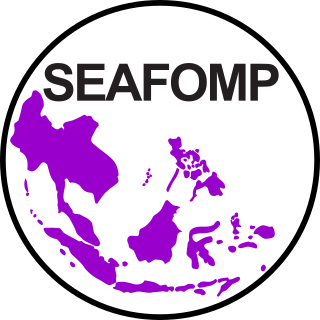
South East Asian Federation of Organizations for Medical Physics (SEAFOMP) was officially formed when it was accepted as a regional chapter of the International Organization for Medical Physics (IOMP) at the World Congress on Medical Physics and Biomedical Engineering, held in Chicago, Illinois, in 2000.
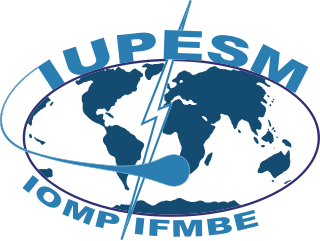
The International Union for Physical and Engineering Sciences in Medicine (IUPESM) is an international non-governmental organization - the umbrella organization for the International Organization for Medical Physics (IOMP) and International Federation of Medical and Biological Engineering (IFMBE).
The College of Radiology, Academy of Medicine Malaysia is a non-profit organization of clinical radiologists, clinical oncologists, and medical physicists in Malaysia.
The International Day of Radiology (IDoR) is an annual event promoting the role of medical imaging in modern healthcare. It is celebrated on November 8 each year and coincides with the anniversary of the discovery of x-rays. It was first introduced in 2012, as a joint initiative of the European Society of Radiology (ESR), the Radiological Society of North America (RSNA), and the American College of Radiology (ACR). The International Day of Radiology is acknowledged and celebrated by nearly 200 national, sub-speciality, and related societies around the world.
Sudarshan Kumar Aggarwal is an Indian medical doctor and radiologist. He was honoured by the Government of India, in 2013, by bestowing on him the Padma Shri, the fourth highest civilian award, for his contributions to the field of medicine.
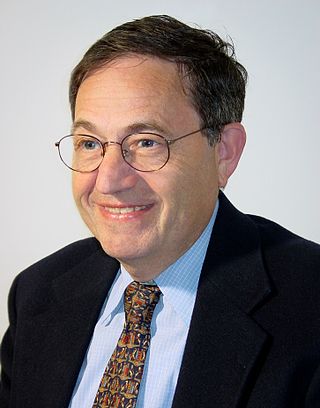
Ferenc Andras Jolesz was a Hungarian-American physician and scientist best known for his research on image guided therapy, the process by which information derived from diagnostic imaging is used to improve the localization and targeting of diseased tissue to monitor and control treatment during surgical and interventional procedures. He pioneered the field of Magnetic Resonance Imaging-guided interventions and introduced of a variety of new medical procedures based on novel combinations of imaging and therapy delivery.
Global radiology, a subspecialty of diagnostic radiology, comprises the study and practice of improving access to radiology resources in poor and developing countries, and addressing global health inequities through the application of radiology. Similar to the fields of public health and global health, global radiology draws on and encourages collaboration with nonmedical specialties relevant to disease patterns and the provision of medical services, including economic development, biomedical technology, engineering and social sciences.
Eleanor D. Montague was an American radiologist and educator who established breast-conserving therapy in the United States and improved radiation therapy techniques. She became a member of the Texas Women's Hall of Fame in 1993.

Jonathan S. Lewin is an American neuroradiologist specializing in medical imaging research with an emphasis on the investigation, development, and translation of new magnetic resonance imaging (MRI) techniques. He is the former executive vice president for health affairs (EVPHA) and executive director of the Woodruff Health Sciences Center for Emory University, and former President, CEO, and chairman of the board of Emory Healthcare. He currently serves as professor of radiology, biomedical engineering, and neurosurgery in the Emory School of Medicine and as professor of health policy and management in the Rollins School of Public Health.
The European Federation of Organisations for Medical Physics (EFOMP) was founded in May 1980 in London to serve as an umbrella organisation representing the national Medical Physics societies in Europe. The office moved to Utrecht in January 2021. It is a non-profit organisation and aims to foster and coordinate the activities of its national member organisations, encourage exchange and dissemination of professional and scientific information, develop guidelines for education, training and accreditation programmes and to make recommendations on the responsibilities, organisational relationships and roles of medical physicists.










